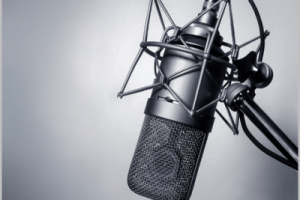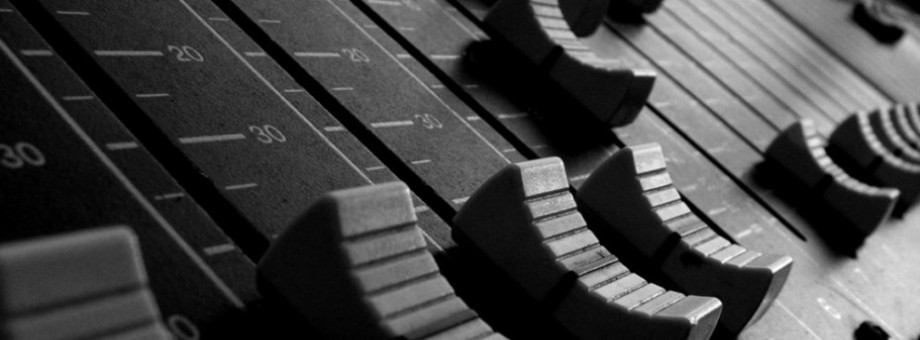Recording Your First Audiobook
Voice over director and audio engineer Paul Fegan pens this article on the process of recording audiobooks.
[hr]
I have been recording, directing and post-producing voiceover audio for the past 15 years. But until last summer, I had never recorded an audio book. An English author, Samsun Lobe, contacted me out of the blue and asked if I’d produce the audio book version of his first novel, RUIN: Birth of a Legend, a fantasy-fiction tale set in a Tolkienesque world. I had always wanted to record an audio book, so I was very excited.
Although the main protagonist in his story was male, Samsun was adamant he wanted a US female to voice his book. I presented him with the demos from my pool of voiceover artists and he chose a Floridian by the name of Lesa Thurman. I’ve enjoyed working with Lesa on so many previous projects and I have to take my hat off to Samsun: he chose wisely and Lesa did a fantastic job.
So what did we learn in the process?
Well, I always find it interesting how every voiceover-related project has its own unique read, whether it’s for eLearning, advertisements, IVR or whatever. Here in Ireland, for instance, I’ve even noticed a difference between TV news-reads and radio news-reads. It’s such a subtle difference that you might only notice it when you try to emulate it. I love analysing new reads and finding out what makes them work. With that in mind, I knew that audio book reads, too, would have their own peculiarities. If you’re an audio book veteran, you’ll know many of these. If you’re a newcomer, you might not. Nonetheless, what follows is a list of some of the discoveries we made while recording this, our first audio book.
When I was initially commissioned to record this book, I sought some advice from voiceover artists who had experience recording for the genre. One piece of advice I was given was: read the book! Twice, if you can. Know it inside out. I must confess that while we read the first few chapters before entering the studio, we hadn’t read the whole book. We were too eager to start recording because, having never recorded an audio book before, we had no idea how long it would take. The deadline was some months away, but we felt we should make a start straight away. So when we came to the chapters we hadn’t pre-read, it was slow going and from then on we decided to read each chapter before we recorded it. This isn’t ideal, so I recommend you do what we didn’t and read the whole book beforehand. You’ll be better informed going into the studio and you’ll also have a reasonable idea of the different types of characters that are coming up.
Speaking of characters, one of the first things we did was decide not only how the main character would sound, but how the narrator would sound also. The latter was less to do with Lesa trying to put on a different voice and more to do with finding the right tone for the read. If you’ve read the book, or at least read a few chapters like we had, you’ll have a good inkling as to the opening tone. This will change depending on what’s happening in the narrative, but we’ll come to that. As for the main character: in all likelihood, he or she is going to have the greatest number of lines. So find a good voice that suits their physical description and the type of person they are, but also, find a voice with which you’re comfortable. There’s no point in adopting a voice that rips your throat out after the first paragraph and has you drinking a few gallons of honey and warm water.
Of course, there will be other characters, too. Some books may be written around just a small band of them, but this wasn’t the case with RUIN. We came across a lot of colourful characters, all with different attributes and physical descriptions. So what are you supposed do you do here? Do you endeavour to find a voice for everyone? Well, no. Remember, you’re a storyteller. If you were telling a group of friends about something that happened at work, you might impersonate some of the people involved, but your friends would be in no doubt that it was just you, on your own, telling this story. It’s the same with audio books. If the listener knows there’s just one voiceover artist reading the story, they know you’re just going to impersonate some of the characters; they’re not deluded into thinking you’re a whole cast of actors. So go easy on yourself. When you read the book through, you’ll get a good idea as to which characters feature strongly and which ones only appear for a line or two. Do your best to find voices; it’s fun and it’s likely part of what you love about voicing audio books. But don’t worry if you can’t do a whole range of them, especially for the characters who only appear briefly, like the barman at the inn, or the guy who is slaughtered at the start of the book. When we were recording RUIN, Lesa pulled a surprising amount of voices out of the hat and you’ll probably have a similar experience when you push yourself. But don’t put yourself under any undue pressure. Again, you’re a storyteller and the most important thing is that you can ‘tell’ the story.
Of all the tips we picked up while recording our audio book, I think this next one was for me one of the easiest to implement, yet one of the most effective. We had started chapter 2 or 3 and we were a few pages in and we just didn’t feel it was working. In the scene, two of the characters were trying to escape a fortress at night. Lesa was giving it her all and she sounded great. So why wasn’t it working? I stopped the recording and I remember trying to imagine how it should sound. Then I had an idea. I scrolled back to the top of the chapter and I asked Lesa if she’d mind starting again. She was as obliging as ever. This time, I suggested to her that if the characters were creeping around and whispering, maybe the narrator should be, too. Perhaps the narrator was like an embedded journalist accompanying a platoon of soldiers in a battle zone. So when stealth was of the utmost importance, the narrator might just whisper. When all Hell was breaking loose, the narrator would almost need to raise their voice above the action. We tried this, Lesa nailed it and I thought the results were well worth the re-record. So this is one tip I highly recommend. Don’t just read it — live it.
Now, this is more of an editing comment, but I want to broach the subject of breath intakes. I come from a predominantly eLearning background and I usually mute breath intakes unless they’re crucial to the audio. I tried to do something different with this audio book, but within a short time, I found myself reverting to my eLearning audio practice. So when I was editing Lesa’s narration, I would remove all the breath intakes. When I was editing Lesa’s dialogue, I handled the breaths on a line by line basis. You’ll find that in some sections, breath intakes are as important as the words in terms of conveying mood and feeling. For instance, if someone gasps or is out of breath from running, it’s important that we hear those breaths. So whether you’re editing this yourself, or outsourcing the task to a professional audio editor, be careful which breath intakes are removed and which ones are left intact.

In a similar vein to what I’ve mention in the two paragraphs above, be mindful of other human sounds that may or may not be in the script, but which will help reinforce the mood and carry the story. For a start, if a line of dialogue ends with “she laughed”, that character needs to laugh. Stop and think how you’re going to do this. Did she start laughing at the beginning of her line, or is there something in the middle which is obviously making her laugh, but only from that point on? If it’s at the start of a line, begin by doing a few practice laughs. Yes, I know what you’re thinking: it feels a bit daft. But sometimes, when you’re at your most self-conscious in the booth, you’re really just hitting the mark. So, if required, get a good laugh going, make it convincing and then launch into the line as written in the text. I assure you that if you time this right, it’ll raise the dialogue off the page and bring the scene to life, especially if there’s intended humour involved. And it’s also OK if you can hear the narrator smile a little as she reads ‘she laughed’. It’s all part of being embedded.
So that’s one thing, but here’s another. Let’s say a character places an arrow in their bow and pulls back on the string and then they say something, think about how they’re going to sound. One thing is for certain: speaking normally and casually won’t be very convincing. Do this: physically act out holding up a bow and pulling back the string. Go on, do it. The string is very tight and you’re pulling back as far as you can and aiming at an enemy some distance away. What’s happening to your body? Well chances are, you’re tightening the muscles in both arms, your head is tilted, you’ve one eye closed and you’re holding your breath, thus tightening your diaphragm. Now while maintaining this posture, say a few words. Chances are, you sound like you’re tensing up and almost speaking through your teeth as you try to aim that bow. If you read your dialogue now, the listener will be far more convinced by your character’s situation.
Remember earlier we considered how an embedded journalist might whisper or shout, depending on what was going on around them? Well, similarly, try to adjust your pace for whatever’s going on in the action. If the door has suddenly swung open. Some is standing there. A sword glints in the candlelight. Then WHAM! Well then you know the action has ramped up a tad and whether the sentences are staccato or not, you might speak more rapidly here to convey a sense of how fast these events are unfolding. You could even try reading longer sentences in a staccato manner so that the lines punch out of the page more. Add a sense of urgency to your voice, too and perhaps increase your volume. As we said earlier, your narration might need to be ‘heard’ above the din of the action. In another section, maybe the Moon hangs over a glassy lake. The sky is ablaze with white stars and the main character has never known such peace. Here, you could adopt a calm voice and leave plenty… of space… between those lines. Just let yourself drift into the serenity of the scene and don’t worry if any gaps are too long, or even too short. This can all be fixed in post. The important thing is that you go with the mood of the scene, for if you do, in all likelihood it will result in a great, great read.
I remember another scene in the book and it was set the day before a battle. One of the characters was giving one of those battle-rallying speeches like you might have seen in Gladiator or Braveheart: “Tomorrow… we fight!” or something to that effect. We initially tried speaking loudly. But it wasn’t very effective. I mean, we have someone who’s trying to rally warriors to his banner; the blood is pumping; the adrenaline is flowing; their lives will depend on this. It’s not really something you just say loudly as though you’re reminding a departing crowd not to forget their coats after a party. And impersonating a shout won’t cut it, either. In my opinion, you really only have one option here: to shout it from the bottom of your lungs. But won’t that redline the meters and cause distortion? Well, there are two things you can do to make sure it doesn’t. Firstly, you can use a compressor. To those who aren’t familiar, a compressor is a device that sits between your microphone and your recording device (audio interface, sound card, etc.) and its job is to watch out for levels that go above a certain threshold. If they do, the compressor will reduce them by a defined amount. Ideally, you should have one of these in your set-up. Now, chances are you’ll set up your compressor for volume fluctuations in your speech, but sometimes, the compressor won’t be able to act fast enough to cope with the sudden, ear-shattering volume levels of our Braveheart speech. It will help, though. So what is the second thing? Well, that’s simply mic technique. Try bellowing out the line the way you imagine it would be delivered in a movie. Look at the meters as you’re doing this, or defer to your engineer if you’re recording with one. If the levels are redlining, pull back from the mic a few inches and try again. Keep going until you’re seeing safe levels and then you’ll know that’s the distance you need to position yourself from the mic for those lines. You’ll lose a bit of presence for sure, but that’s perfectly acceptable as your voice is going to sound very different from the rest of your read anyway. Now, press record and scream your heart out. It’ll sound great.
By the way, another thing I wanted to mention is this: give your listener a sense that you’re finishing one scene and starting another by using appropriate intonation. For instance, for an opening line, pause, take a breath and maybe start a little lighter or higher in tone. There are exceptions to this, of course, but you’ll know what they are when you see them. For instance, if the opening scene is grim, a lighter tone won’t be appropriate but you can still use your voice to indicate it’s a new scene. Always take a decent pause after one scene and clear your mind of it before you start the next one. And at the end of a scene, resolve your lines using your pace and intonation. This will help clarify to the listener the shift from one scene to the next.
Before I finish up, I have one final piece of advice to impart. This relates to all of those character voices we spoke about earlier. Let’s say a woman called Janet appears in chapter 2 and you find a voice for her, but then she doesn’t reappear until chapter 14. Chances are, by then, you’ll have voiced so many characters that you may well have forgotten how Janet sounded. Myself and Lesa had this conversation once or twice: “Oh her, was she the one who spoke like this? No? Oh, that was the mercenary. Then who was this one?” Sound familiar? At that point, unless you have a moment of enlightenment, you’re going to have to trawl back through hours of perhaps-unedited audio to find Janet’s lines and it can be a little like finding a needle in a haystack. And you’ve had to stop recording. You’re distracted now. And you’re losing your flow. We found that the best thing to do here was to note down every character you come across and when you find a voice for them, save an audio clip of their voice into a folder for reference. Then, anytime old characters return, you can quickly consult your ‘characters’ folder and refresh your memory. This is well worth the minute or so it takes to do this.
I’m sure there are other tips I could impart, but the above covers the main ones. Discovering these facets of recording audio books was hugely beneficial to us and I hope they’ll be beneficial to you, too. But nothing’s cast in stone; different methods work for different people. Try out different ideas and see what works for you. And above all, enjoy every moment of your next recording.

